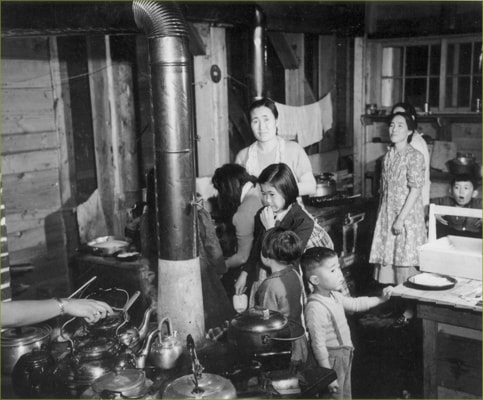Japanese Internment in Greenwood
BY: BG EDITOR

People of Japanese ancestry depart by train for an internment camp, 1942
[ Photo: National Archives of Canada ]
July, 2016 — GREENWOOD, BC (BG)
Although Greenwood had prospered greatly during the first decade of the 1900's, by the end of World War I the bust in copper demand and prices and a shortage of ore sent the city into a downward spin. When the copper smelting operation came to a close, the population scattered.
In 1942, however, Greenwood benefited from what was the great misfortunate of another community: western Canada's Japanese-Canadians. At the mid-point of WWII, thousands of Japanese people were forced to leave their homes and businesses on the west coast.
World War II lasted from 1939 through 1945, with the attack on Pearl Harbor taking place in December 1941. Immediately after Pearl Harbor, both the U.S. and Canadian governments moved to detain, relocate and intern their Japanese residents, including those who had become citizens.
"On January 14, 1942, a 100-mile wide strip along the coast was designated a "protected area" by the federal government and all male Japanese Canadians between the ages of 18 and 45 were to be removed from the area and taken to road camps in the interior.
On March 4, 1942, all people of Japanese racial origin were told to leave the protected area. A dusk to dawn curfew was imposed and enforced by police. Most of the Japanese with either naturalized citizens or born in Canada.
Japanese Canadians were told to pack a single suitcase each and taken to holding areas, to wait for trains to take them inland. Vancouver's Hastings Park was one of areas where families waited, sometimes for months, to be relocated."
("Le Canada - A People's History - CBC.ca)

Community home kitchen where food was prepared and taken to each apartment for serving
in the Japanese internment camp in Greenwood, B.C., c. 1943.
[ Photo: National Archives of Canada ]
Greenwood mayor W.E. McArthur put in a request to have 1,200 Japanese moved to Greenwood, to help resuscitate the local economy. Arriving by train over the course of a few months, they were interned in vacant homes and buildings that had once been occupied by Greenwood residents during the mining boom. The facilities were austere, with communal kitchens, shared bathing and toilet facilities, and often little protection from the harsh cold of a mountain winter.
These 1,200 were among the 22,000 Japanese people who were forced to leave their coastal homes, in what was the largest mass movement of people ever in the history of Canada.
By this unfortunate turn of events Greenwood was saved from becoming a ghost town, like many other mining townsites in the southern interior. The Japanese-Canadians had injected new life into the city.
In 1945, when the Axis powers finally surrendered, bringing the war to an end, Greenwood expressed appreciation for its newest community members and encouraged them to stay, despite government pressure to impose further penalties of deportation or ejection:
"After the war, the federal government decided to remove all Japanese Canadians from British Columbia. They forced them to choose between deportation to war-ravaged Japan or dispersal east of the Rocky Mountains. Most chose the latter, moving to Ontario, Quebec and the Prairie provinces.
Public protest would eventually stop the deportations, but not before 4,000 Japanese Canadians left the country. On 1 April 1949, Japanese Canadians regained their freedom to live anywhere in Canada. (CBC's "Le Canada - A People's History")

Group of Japanese Canadian girls participating in
Bon-Odori (summer festival) at Greenwood, c. 1942
[ Photo: University of British Columbia Library ]
Greenwood City Council sent a letter to the federal government asking that its Japanese residents be allowed to remain here. That letter is prominently displayed in the Greenwood Museum, part of an excellent display on this important phase of Greenwood's history.
About half of the interned Japanese chose to stay in Greenwood. Today, many of them or their descents still call Greenwood home.







